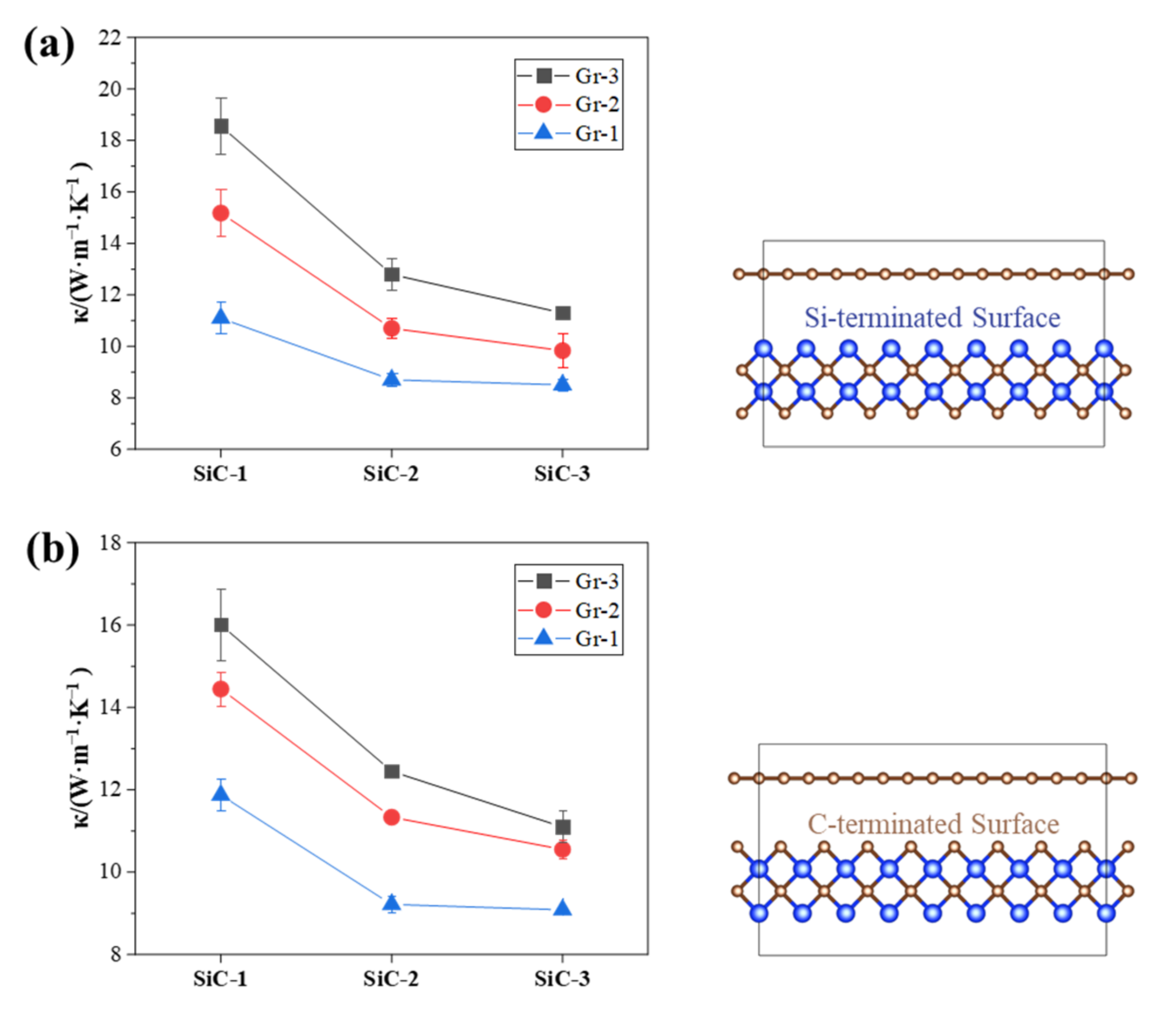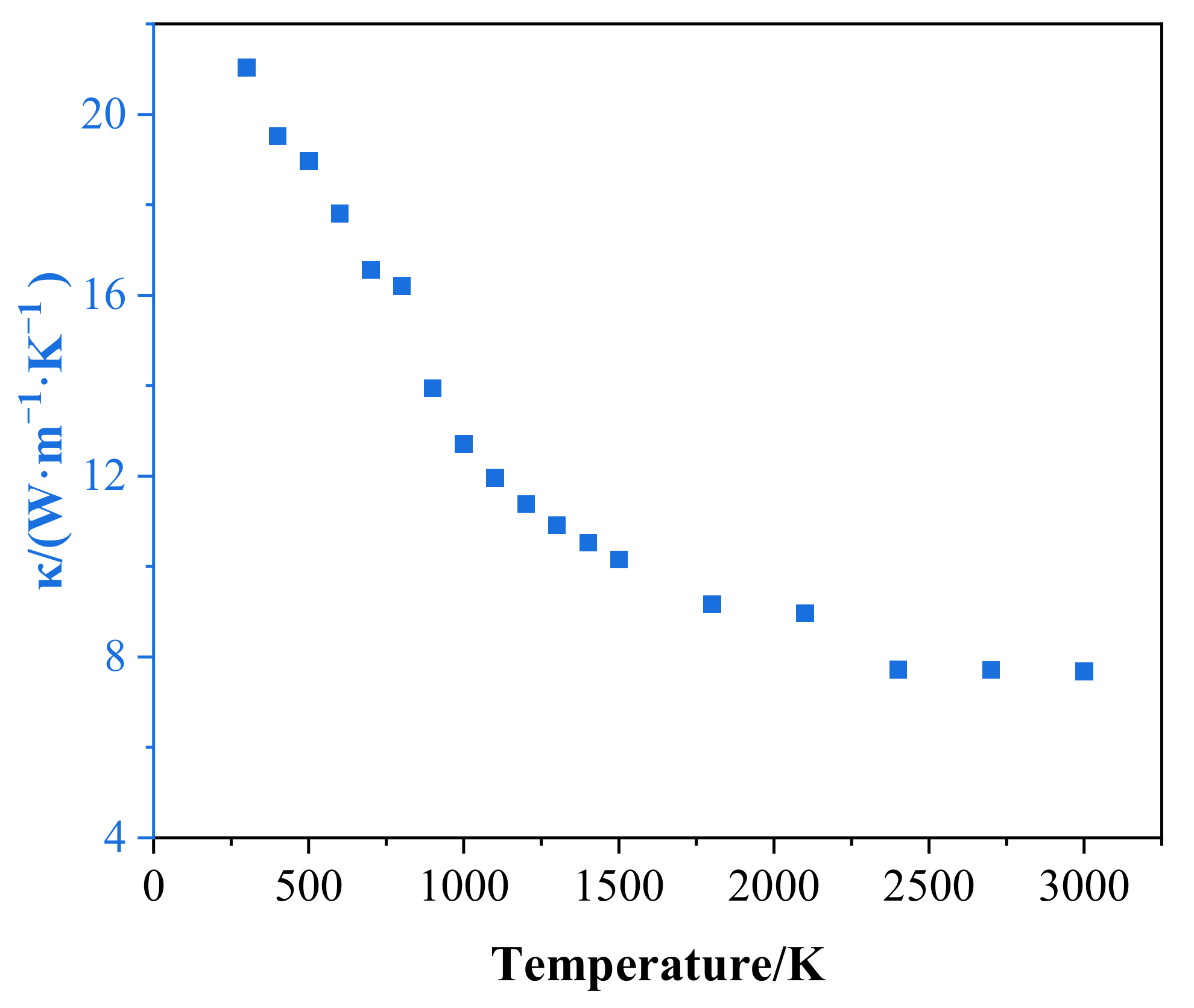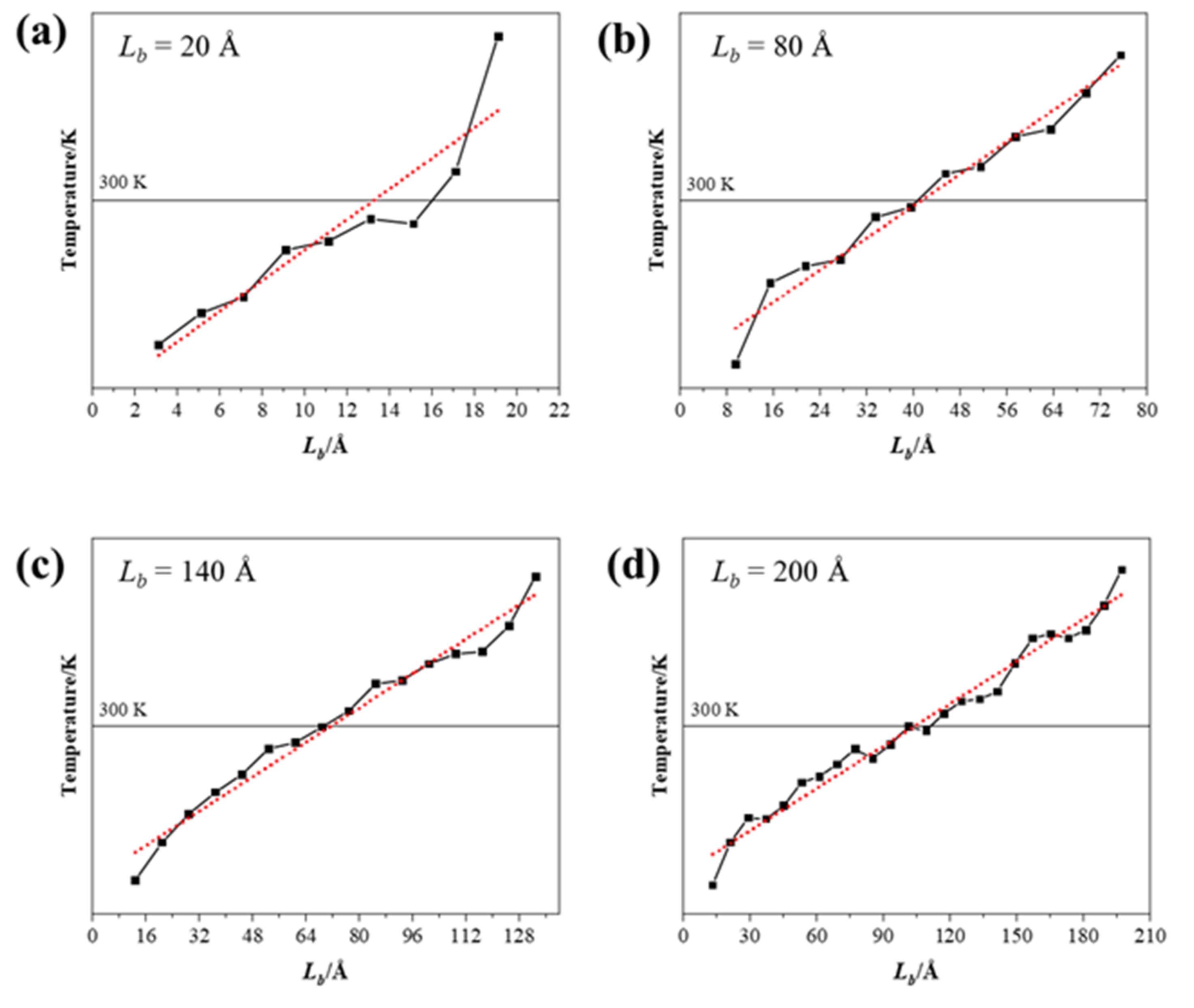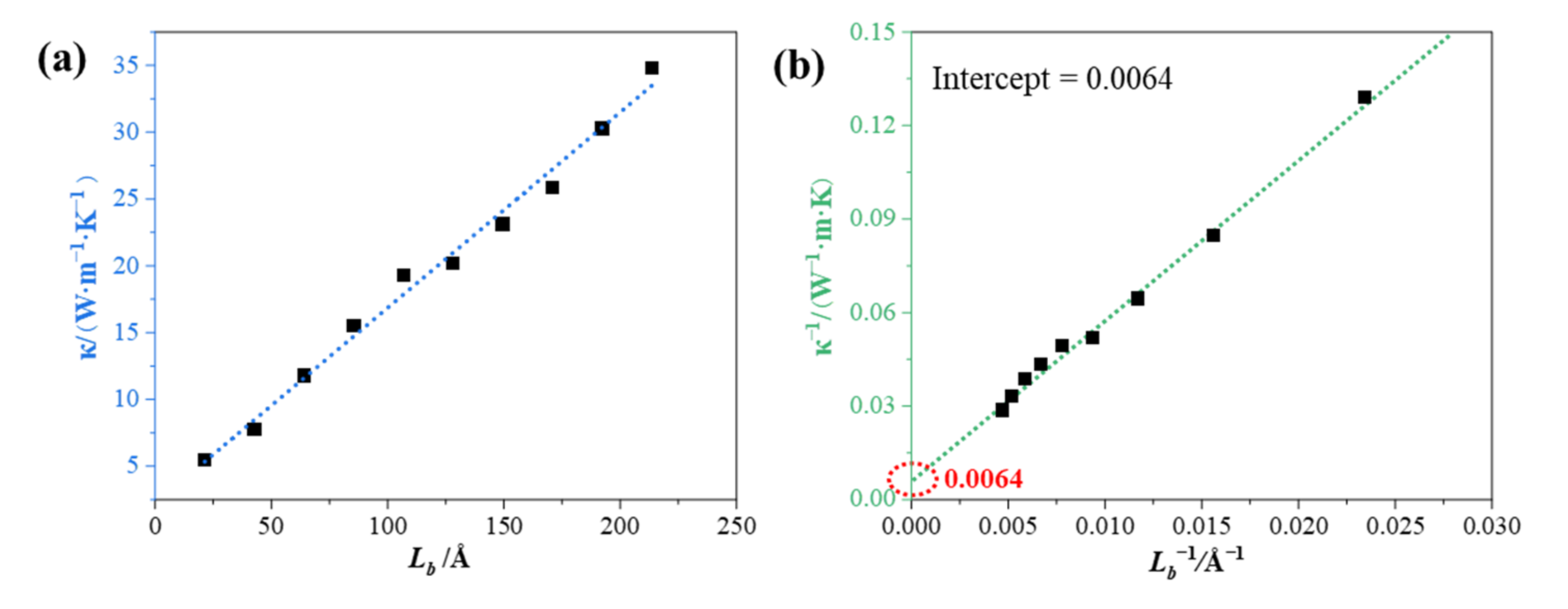Enhanced Thermal Transport Properties of Graphene/SiC Heterostructures on Nuclear Reactor Cladding Material: A Molecular Dynamics Insight
Abstract
:1. Introduction
2. Computational Methods
2.1. LAMMPS Calculation
2.2. Potential Function
2.3. NEMD Method
3. Results and Discussion
3.1. Composite Structure
3.2. Temperature Dependance of Thermal Conductivity
3.3. Finite-Size Effect of Thermal Conductivity
4. Conclusions
Author Contributions
Funding
Acknowledgments
Conflicts of Interest
References
- Gong, F.; Li, H.; Huang, J.; Jing, Y.; Hu, Z.; Xia, D.; Zhou, Q.; Xiao, R. Low-grade energy harvesting from dispersed exhaust steam for power generation using a soft biomimetic actuator. Nano Energy 2021, 91, 106677. [Google Scholar] [CrossRef]
- Lv, Y.; Gong, F.; Li, H.; Zhou, Q.; Wu, X.; Wang, W.; Xiao, R. A flexible electrokinetic power generator derived from paper and ink for wearable electronics. Appl. Energy 2020, 279, 115764. [Google Scholar] [CrossRef]
- Xu, Y.; Kang, J.; Yuan, J. The Prospective of Nuclear Power in China. Sustainability 2018, 10, 2086. [Google Scholar] [CrossRef] [Green Version]
- Fernández-Arias, P.; Vergara, D.; Orosa, J.A. A Global Review of PWR Nuclear Power Plants. Appl. Sci. 2020, 10, 4434. [Google Scholar] [CrossRef]
- Qiu, B.; Wang, J.; Deng, Y.; Wang, M.; Wu, Y.; Qiu, S. A review on thermohydraulic and mechanical-physical properties of SiC, FeCrAl and Ti3SiC2 for ATF cladding. Nucl. Eng. Technol. 2020, 52, 1–13. [Google Scholar] [CrossRef]
- Mustafa, S.S. Investigation of the safety features of advanced PWR assembly using SiC, Zr, FeCrAl and SS-310 as cladding materials. Sci. Rep. 2021, 11, 1–18. [Google Scholar] [CrossRef] [PubMed]
- Newsome, G.; Snead, L.L.; Hinoki, T.; Katoh, Y.; Peters, D. Evaluation of neutron irradiated silicon carbide and silicon carbide composites. J. Nucl. Mater. 2007, 371, 76–89. [Google Scholar] [CrossRef] [Green Version]
- Ang, C.K.; Raiman, S.S.; Burns, J.R.; Hu, X.; Katoh, Y. Evaluation of the First Generation Dual-purpose Coatings for SiC Cladding. Nucl. Technol. Res. Dev. 2017, 318, 1–42. [Google Scholar]
- Fu, Y.; Hansson, J.; Liu, Y.; Chen, S.; Zehri, A.; Samani, M.K.; Wang, N.; Ni, Y.; Zhang, Y.; Zhang, Z.-B.; et al. Graphene related materials for thermal management. 2D Mater. 2020, 7, 012001. [Google Scholar] [CrossRef]
- Balandin, A.A.; Ghosh, S.; Bao, W.; Calizo, I.; Teweldebrhan, D.; Miao, F.; Lau, C.N. Superior Thermal Conductivity of Single-Layer Graphene. Nano Lett. 2008, 8, 902–907. [Google Scholar] [CrossRef]
- Chen, C.; Han, X.C.; Shen, H.H.; Tan, Y.Q.; Zhang, H.B.; Qin, Y.; Peng, S.M. Preferentially oriented SiC/graphene composites for enhanced mechanical and thermal properties. Ceram. Int. 2020, 46, 23173–23179. [Google Scholar] [CrossRef]
- Gong, F.; Ding, Z.; Fang, Y.; Tong, C.-J.; Xia, D.; Lv, Y.; Wang, B.; Papavassiliou, D.V.; Liao, J.; Wu, M. Enhanced Electrochemical and Thermal Transport Properties of Graphene/MoS2 Heterostructures for Energy Storage: Insights from Multiscale Modeling. ACS Appl. Mater. Interfaces 2018, 10, 14614–14621. [Google Scholar] [CrossRef] [PubMed]
- Chu, K.; Wang, X.-H.; Li, Y.-B.; Huang, D.-J.; Geng, Z.-R.; Zhao, X.-L.; Liu, H.; Zhang, H. Thermal properties of graphene/metal composites with aligned graphene. Mater. Des. 2018, 140, 85–94. [Google Scholar] [CrossRef]
- Shen, X.; Wang, Z.; Wu, Y.; Liu, X.; He, Y.-B.; Kim, J.-K. Multilayer Graphene Enables Higher Efficiency in Improving Thermal Conductivities of Graphene/Epoxy Composites. Nano Lett. 2016, 16, 3585–3593. [Google Scholar] [CrossRef] [PubMed] [Green Version]
- Cheng, Y.; Tan, M.; Hu, P.; Zhang, X.; Sun, B.; Yan, L.; Zhou, S.; Han, W. Strong and thermostable SiC nanowires/graphene aerogel with enhanced hydrophobicity and electromagnetic wave absorption property. Appl. Surf. Sci. 2018, 448, 138–144. [Google Scholar] [CrossRef]
- Vajdi, M.; Moghanlou, F.S.; Nekahi, S.; Ahmadi, Z.; Motallebzadeh, A.; Jafarzadeh, H.; Asl, M.S. Role of graphene nano-platelets on thermal conductivity and microstructure of TiB2–SiC ceramics. Ceram. Int. 2020, 46, 21775–21783. [Google Scholar] [CrossRef]
- Yang, H.; Li, Q.; Wang, Z.; Wu, H.; Wu, Y.; Hou, P.; Cheng, X. Effect of Graphene on Microstructure and Mechanical Properties of Si3N4/SiC Ceramics. ES Mater. Manuf. 2021, 12, 29–34. [Google Scholar] [CrossRef]
- Freitas, R.; Asta, M.; de Koning, M. Nonequilibrium free-energy calculation of solids using LAMMPS. Comput. Mater. Sci. 2016, 112, 333–341. [Google Scholar] [CrossRef]
- Kong, L.T.; Bartels, G.; Campaná, C.; Denniston, C.; Müser, M.H. Implementation of Green’s function molecular dynamics: An extension to LAMMPS. Comput. Phys. Commun. 2009, 180, 1004–1010. [Google Scholar] [CrossRef]
- Kawamura, T.; Hori, D.; Kangawa, Y.; Kakimoto, K.; Yoshimura, M.; Mori, Y. Thermal Conductivity of SiC Calculated by Molecular Dynamics. Jpn. J. Appl. Phys. 2008, 47, 8898–8901. [Google Scholar] [CrossRef]
- Pop, E.; Varshney, V.; Roy, A.K. Thermal properties of graphene: Fundamentals and applications. MRS Bull. 2012, 37, 1273–1281. [Google Scholar] [CrossRef] [Green Version]
- Gong, F.; Li, H.; Zhou, Q.; Wang, M.; Wang, W.; Lv, Y.; Xiao, R.; Papavassiliou, D.V. Agricultural waste-derived moisture-absorber for all-weather atmospheric water collection and electricity generation. Nano Energy 2020, 74, 104922. [Google Scholar] [CrossRef]
- Mao, Y.; Li, Y.; Xiong, Y.; Xiao, W. Point defect effects on the thermal conductivity of β-SiC by molecular dynamics simulations. Comput. Mater. Sci. 2018, 152, 300–307. [Google Scholar] [CrossRef]
- Zhou, Q.; Gong, F.; Xie, Y.; Xia, D.; Hu, Z.; Wang, S.; Liu, L.; Xiao, R. A general strategy for designing metal-free catalysts for highly-efficient nitric oxide reduction to ammonia. Fuel 2021, 310, 122442. [Google Scholar] [CrossRef]
- Ong, Z.-Y.; Pop, E. Frequency and polarization dependence of thermal coupling between carbon nanotubes and SiO2. J. Appl. Phys. 2010, 108, 103502. [Google Scholar] [CrossRef] [Green Version]
- Fan, Z.; Wang, Y.; Gu, X.; Qian, P.; Su, Y.; Ala-Nissila, T. A minimal Tersoff potential for diamond silicon with improved descriptions of elastic and phonon transport properties. J. Phys. Condens. Matter 2019, 32, 135901. [Google Scholar] [CrossRef] [PubMed] [Green Version]
- Dhaliwal, G.; Nair, P.B.; Singh, C.V. Uncertainty analysis and estimation of robust AIREBO parameters for graphene. Carbon 2019, 142, 300–310. [Google Scholar] [CrossRef]
- Ong, Z.-Y.; Pop, E. Molecular dynamics simulation of thermal boundary conductance between carbon nanotubes and SiO2. Phys. Rev. B 2010, 81, 155408. [Google Scholar] [CrossRef] [Green Version]
- Evans, D.J. Homogeneous NEMD algorithm for thermal conductivity—Application of non-canonical linear response theory. Phys. Lett. A 1982, 91, 457–460. [Google Scholar] [CrossRef]
- Plimpton, S. Fast Parallel Algorithms for Short-Range Molecular Dynamics. J. Comput. Phys. 1995, 117, 1–19. [Google Scholar] [CrossRef] [Green Version]
- Zou, J.-H.; Ye, Z.-Q.; Cao, B.-Y. Phonon thermal properties of graphene from molecular dynamics using different potentials. J. Chem. Phys. 2016, 145, 134705. [Google Scholar] [CrossRef] [PubMed]
- Schelling, P.K.; Phillpot, S.; Keblinski, P. Comparison of atomic-level simulation methods for computing thermal conductivity. Phys. Rev. B 2002, 65, 144306. [Google Scholar] [CrossRef] [Green Version]
- Chantrenne, P.; Barrat, J.-L. Finite Size Effects in Determination of Thermal Conductivities: Comparing Molecular Dynamics Results with Simple Models. J. Heat Transf. 2004, 126, 577–585. [Google Scholar] [CrossRef] [Green Version]
- Allen, M.P.; Tildesley, D.J. Computer Simulation of Liquids; Oxford University Press: Oxford, UK, 2017. [Google Scholar]
- Gong, F.; Liu, X.X.; Yang, Y.; Xia, D.; Wang, W.; Duong, H.M.; Papavassiliou, D.V.; Xu, Z.; Liao, J.; Wu, M. A Facile Approach to Tune the Electrical and Thermal Properties of Graphene Aerogels by Including Bulk MoS2. Nanomaterials 2017, 7, 420. [Google Scholar] [CrossRef] [Green Version]
- Gong, F.; Wang, W.; Li, H.; Xia, D.; Papavassiliou, D.V. Predictions of the thermal conductivity of multiphase nanocomposites with complex structures. J. Mater. Sci. 2018, 53, 12157–12166. [Google Scholar] [CrossRef]
- Lukes, J.R.; Zhong, H. Thermal Conductivity of Individual Single-Wall Carbon Nanotubes. J. Heat Transf. 2007, 129, 705–716. [Google Scholar] [CrossRef] [Green Version]
- Galamba, N.; De Castro, C.A.N.; Ely, J.F. Equilibrium and nonequilibrium molecular dynamics simulations of the thermal conductivity of molten alkali halides. J. Chem. Phys. 2007, 126, 204511. [Google Scholar] [CrossRef]
- Stevens, R.J.; Zhigilei, L.V.; Norris, P.M. Effects of temperature and disorder on thermal boundary conductance at solid–solid interfaces: Nonequilibrium molecular dynamics simulations. Int. J. Heat Mass Transf. 2007, 50, 3977–3989. [Google Scholar] [CrossRef]
- Uma, S.; McConnell, A.D.; Asheghi, M.; Kurabayashi, K.; Goodson, K.E. Temperature-Dependent Thermal Conductivity of Undoped Polycrystalline Silicon Layers. Int. J. Thermophys. 2001, 22, 605–616. [Google Scholar] [CrossRef]
- Ganster, P.; Benoit, M.; Kob, W.; Delaye, J.-M. Structural properties of a calcium aluminosilicate glass from molecular-dynamics simulations: A finite size effects study. J. Chem. Phys. 2004, 120, 10172–10181. [Google Scholar] [CrossRef] [Green Version]
- Celebi, A.T.; Jamali, S.H.; Bardow, A.; Vlugt, T.J.H.; Moultos, O.A. Finite-size effects of diffusion coefficients computed from molecular dynamics: A review of what we have learned so far. Mol. Simul. 2021, 47, 831–845. [Google Scholar] [CrossRef]







| Elements | ε (eV) | σ (Å) |
|---|---|---|
| Si-C | 0.00891 | 3.629 |
| Si-Si | 0.01740 | 3.826 |
| C-C | 0.00455 | 3.431 |
Publisher’s Note: MDPI stays neutral with regard to jurisdictional claims in published maps and institutional affiliations. |
© 2022 by the authors. Licensee MDPI, Basel, Switzerland. This article is an open access article distributed under the terms and conditions of the Creative Commons Attribution (CC BY) license (https://creativecommons.org/licenses/by/4.0/).
Share and Cite
Wu, L.; Sun, X.; Gong, F.; Luo, J.; Yin, C.; Sun, Z.; Xiao, R. Enhanced Thermal Transport Properties of Graphene/SiC Heterostructures on Nuclear Reactor Cladding Material: A Molecular Dynamics Insight. Nanomaterials 2022, 12, 894. https://doi.org/10.3390/nano12060894
Wu L, Sun X, Gong F, Luo J, Yin C, Sun Z, Xiao R. Enhanced Thermal Transport Properties of Graphene/SiC Heterostructures on Nuclear Reactor Cladding Material: A Molecular Dynamics Insight. Nanomaterials. 2022; 12(6):894. https://doi.org/10.3390/nano12060894
Chicago/Turabian StyleWu, Lei, Xiangyang Sun, Feng Gong, Junyi Luo, Chunyu Yin, Zhipeng Sun, and Rui Xiao. 2022. "Enhanced Thermal Transport Properties of Graphene/SiC Heterostructures on Nuclear Reactor Cladding Material: A Molecular Dynamics Insight" Nanomaterials 12, no. 6: 894. https://doi.org/10.3390/nano12060894






